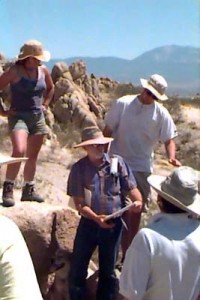 |
PBR Constraints on Seismic Hazard from Known Faults and from Smoothed “Background” SeismicityJames Brune University of Nevada, Reno Wednesday, March 18th, 2015 |
||
|
|||
|
Precariously balanced rocks (PBRs) provide upper limit constraints on ground motion over the time period which they have been in their current positions. In some cases this upper limit appears to be in conflict with current estimates of seismic hazard (2014 maps), e.g. near trans-tensional step-overs and areas where background seismicity dominates the hazard. In the Brune et al. (2008) study removing background seismicity lowered the 2% in 50 yr hazard (2008 estimate) from about .58 to about .48 between the Elsinore and San Jacinto faults. In areas of the Eastern Mojave where there are no known active faults removing the background seismicity decreases the 2% hazard from about 0.2g to 0.1g. In both cases reducing background seismicity brings the hazard into better agreement with PBRs. We discuss possible PBR implications for the ergodic assumption, site effects, source characterization and smoothed seismicity parameters. New data from the Hamadori normal faulting earthquakes is compared with the PBR data near the Genoa fault which had a large earthquake about 300 yrs ago, and suggests that some GMPE curves for normal faulting may be too high at close distances and too low at larger distances. James Brune is a Professor of Geophysics (emeritus) at the Seismological Laboratory, University of Nevada, Reno, where he was Director (1987-1998). He serves on the editorial boards of Geofisica Internacional and Journal of the Indian Geophysical Union, the Advisory Committee of the Berkeley Seismographic Stations, and is a member of the California Earthquake Predication Evaluation Council. He is past president (1970-71) and a medal recipient (1997) of the Seismological Society of America, was a Fellow of the Indian Geophysical Union (1989), and was nominated to the Academy of Creative Endeavors in the Soviet Union (1990). He has received the G.K. Gilbert Award, Seismic Geology (1967), the Arthur L. Day Award (1972), and the J.B. MacIlwane Award of the American Geophysical Union (1962). |
|||

